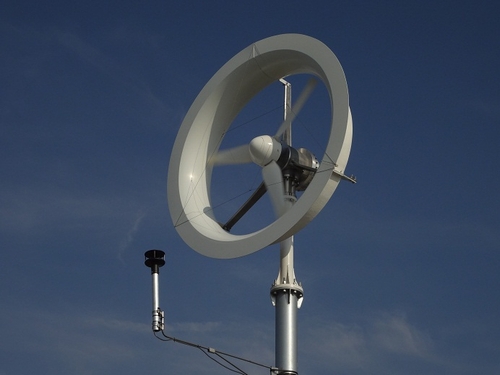January 31, 2013
Japan's National Public Broadcaster Develops Solar-, Wind-Powered TV Camera
Keywords: Environmental Technology Non-manufacturing industry

Copyright NHK
Japan's public broadcasting corporation, NHK, announced on August 29, 2012, the development jointly with Kyushu University of a portable, all-weather robot camera for broadcasting, which can operate during power outages, such as in disasters, by using electricity generated by its own wind-solar hybrid power system.
Its wind turbine has high-efficiency blades with a "wind lens," or brimmed diffuser, which increases the wind's velocity blowing toward the blades, thus allowing the turbine to generate 2.5 times more energy than conventional designs. Reduced in size and weight, the turbine produces about one kilowatt of electricity.
The newly developed camera is also equipped with a large-capacity battery as a backup power source. Even if the hybrid power system fails to generate electricity due to weather conditions, the camera remains operational for about three days with the battery. When the battery runs low, the camera goes into energy-saving mode, in which unnecessary functions are disabled to minimize power consumption. Images taken by the camera can be sent securely, even from disaster area, through various means of transmission.
With the system installed on a rooftop of a building in Watari, Miyagi Prefecture, NHK intends to collect and analyze operational data for about a year, aiming to apply the results to future improvements.
Related JFS article:
City of Fukuoka, Kyushu University to Start Offshore Testing of 'Wind Lens' Turbine
Kyushu University Research Team Discloses Plans for a Mega Hybrid Power Plant on the Ocean
Related
"JFS Newsletter"
Related
"Popular Articles"
- New Nano-Bubble Technology May Help Dissolve Sludge and Improve Water Quality
- Japanese Firm Begins Development of Tidal Power Generation System
- Small Hydropower Generation System Developed for Use in Seawater, Weight Cut by Half
- Constructed Wetland Facility Established by Japanese University Purifies Livestock Farming Drainage
- Toyota CRDL Succeeds in World's First Artificial Photosynthesis Using only Water and CO2


